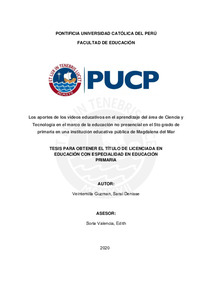| dc.contributor.advisor | Soria Valencia, Edith | |
| dc.contributor.author | Veintemilla Guzman, Sarai Denisse | |
| dc.date.accessioned | 2021-04-21T16:55:51Z | |
| dc.date.available | 2021-04-21T16:55:51Z | |
| dc.date.created | 2020 | |
| dc.date.issued | 2021-04-21 | |
| dc.identifier.uri | http://hdl.handle.net/20.500.12404/18858 | |
| dc.description.abstract | El interés por el estudio del área de Ciencia y Tecnología surge debido a los resultados de la prueba Pisa - 2015 y 2018, en las que se indican que alrededor de la mitad de los estudiantes peruanos no logran explicar los fenómenos científicos que los rodean, las concepciones que presentan se encuentran carentes de información y respaldo científico. Estos resultados son producto de la práctica común en el aula de copiar textualmente los contenidos sin ser comprendidos. Por ello, para el desarrollo de esta capacidad, en el marco de la educación no presencial, se plantea el uso de los video educativos a partir de los siguientes objetivos: Describir las características que tienen los videos educativos que se utilizan en las clases de Ciencia y Tecnología, identificar las funciones de los videos educativos que los docentes presentan en las clases de Ciencia y Tecnología, y describir los aportes de los vídeos educativos en el aprendizaje de Ciencia y tecnología, con respecto al conocimiento científico del mundo natural y artificial. En cuanto a la metodología de investigación, es de enfoque cualitativo, tipo descriptivo y con método estudio de casos. Finalmente, los aportes de los videos educativos son visualizar componentes de difícil observación, la facilidad de comprensión y recuerdo de la información y la promoción de la indagación en los estudiantes, esto se debe a las características del recurso y a sus funciones designadas. Por lo que, esta investigación da a conocer los aportes que tiene el recurso en el aprendizaje del área ciencia y tecnología, contribuyendo a que los estudiantes peruanos logren explicar científicamente los fenómenos científicos que los rodean y se evidencie un incremento en los resultados de las pruebas internacionales | es_ES |
| dc.description.abstract | Interest in studying the area of Science and Technology arises due to the results of the Pisa test - 2015 and 2018, in which it is indicated that around half of Peruvian students fail to explain the scientific phenomena that surround them, the Their conceptions are lacking in information and scientific support. These results are the product of the common practice in the classroom of copying the contents verbatim without being understood. Therefore, for the development of this ability, within the framework of non-face-to-face education, the use of educational videos is proposed based on the following objectives: Describe the characteristics of educational videos used in Science classes and Technology, identify the functions of educational videos that teachers present in Science and Technology classes, and describe the contributions of educational videos in the learning of Science and technology, with respect to scientific knowledge of the natural and artificial world. As for the research methodology, it is qualitative, descriptive and with a case study method. Finally, the contributions of the educational videos are to visualize components that are difficult to observe, the ease of understanding and memory of the information and the promotion of inquiry in students, this is due to the characteristics of the resource and its designated functions. Therefore, this research reveals the contributions that the resource has in learning the science and technology area, helping Peruvian students to scientifically explain the scientific phenomena that surround them and evidence an increase in test results international | es_ES |
| dc.language.iso | spa | es_ES |
| dc.publisher | Pontificia Universidad Católica del Perú | es_ES |
| dc.rights | info:eu-repo/semantics/openAccess | es_ES |
| dc.rights.uri | http://creativecommons.org/licenses/by-nc/2.5/pe/ | * |
| dc.subject | Ciencias--Estudio y enseñanza | es_ES |
| dc.subject | Aprendizaje (Educación) | es_ES |
| dc.subject | Video en educación | es_ES |
| dc.subject | Educación primaria--Perú--Magdalena del Mar (Lima : Distrito) | es_ES |
| dc.title | Los aportes de los videos educativos en el aprendizaje del área de Ciencia y Tecnología en el marco de la educación no presencial en el 5to grado de primaria en una institución educativa pública de Magdalena del Mar | es_ES |
| dc.type | info:eu-repo/semantics/bachelorThesis | es_ES |
| thesis.degree.name | Licenciado en Educación con especialidad en Educación Primaria | es_ES |
| thesis.degree.level | Título Profesional | es_ES |
| thesis.degree.grantor | Pontificia Universidad Católica del Perú. Facultad de Educación | es_ES |
| thesis.degree.discipline | Educación con especialidad en Educación Primaria | es_ES |
| renati.advisor.dni | 10126093 | |
| renati.advisor.orcid | https://orcid.org/0000-0002-2249-7826 | es_ES |
| renati.author.dni | 72389927 | |
| renati.discipline | 112016 | es_ES |
| renati.juror | Soria Valencia, Edith, Llaullipoma Romaní, José Alberto, Puente, Rosa Maria Tafur | es_ES |
| renati.level | https://purl.org/pe-repo/renati/level#tituloProfesional | es_ES |
| renati.type | http://purl.org/pe-repo/renati/type#tesis | es_ES |
| dc.publisher.country | PE | es_ES |
| dc.subject.ocde | http://purl.org/pe-repo/ocde/ford#5.03.01 | es_ES |






